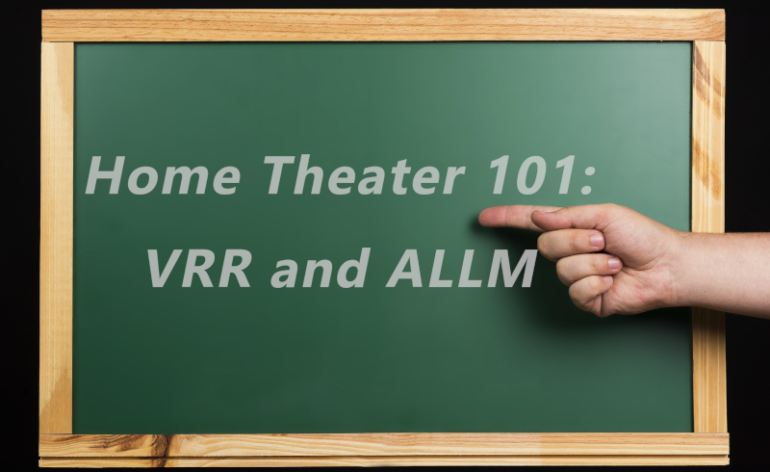VRR and ALLM: Variable Refresh Rate and Auto Low Latency Mode Explained
Audio enthusiasts LOVE their acronyms. AVR, DAC, and HDMI – the list goes on and on. And it grows with each new generation of tech! With the introduction of HDMI 2.1, two new technologies featured heavily: VRR and ALLM, or Variable Refresh Rate and Auto Low Latency Mode. When combined with a next-gen console and a panel that supports these features, gamers will get the best in-game responsiveness, hopefully giving them the edge to dominate. But before you run out and grab devices that support these features, let explain VRR and ALLM in some layman’s terms.
ALLM Explained
Before we talk about VRR, ALLM does exactly what is on the tin – it reduces latency. Auto Low Latency Mode (ALLM) is not a new technology. ALLM has been widely available since 2018(ish). Both Samsung and LG have included it on almost all of their sets since. It is often known as “game mode.” In the simplest terms, ALLM deactivates most processes within your panel that could add input lag or latency, increasing screen response times. Why? For gamers, input lag is often the go to excuse for why they died. You may remember it as, “Hey! I pressed the button and he didn’t jump! That’s not fair!”
What is input lag/response time? It is the amount of time from a button press on your controller to when you see action on the screen. Modern panels have a ton of processing that goes on behind the scenes. Motion smoothing, tone mapping, and AI image-enhancing take time to complete and apply to a frame. And while modern processors do this blazingly fast, it all adds to the response time for a panel, which can lead to input lag, measured in milliseconds. By deactivating all that processing, you bypass any input lag that it could add.
The good news (or bad news if you like motion smoothing) is that most modern consoles turn this on automatically by sending a command to the panel telling it that a game is playing and that it should switch to game mode. But there is another wrinkle. If you use an AVR for video switching, it needs to pass that signal through. The good news is that most AVR’s manufactured since 2018 can do this. However, if you have an older AVR, you can always plug directly into the panel and use ARC (Audio Return Channel, another HDMI function) to pass audio back to your AVR.
But what does this mean in real-world terms? Well, the average gamer has a reaction time of 250 to 500 ms or 0.5 seconds. Pro gamers clock in at 100 ms or 0.1 seconds. Most panels have an input lag of 40ms (0.04 seconds), and with ALLM activated, we see response times of under 10ms (0.01 seconds!). My LG B9 had an input lag of 1.9ms in game mode, or 0.002 seconds elapse between when I pressed a button, and the action showed. For most casual gamers, ALLM will not have any impact on you. But for the pro-gamer, it could mean the difference in winning or losing.

VRR Explained
Now that we’ve address ALLM, let’s talk about VRR. Variable Refresh Rate, or VRR, is, as the name implies, the ability for your panels to vary the refresh rate dynamically based on on-screen content. If you are wondering why your display would need to do this, you are not the only one. And, again, the answer is, “Because of games.”
So with everything else in AV, we need to explain a few things. Refresh rate is how many times, per second, your panel redraws the on-screen image. A 60hz panel will redraw the image 60 times per second, and a 120hz panel will do it 120 times per second. The faster an image redraws, the more frames per second (FPS) you get. For movies, this isn’t critical, as most movies/tv broadcast in 24FPS, and YouTube uses between 30-60FPS. But for most AAA games like Call of Duty or Doom Eternal, 24 FPS is unplayable. VRR comes into play here.
VRR will dynamically control the refresh rate of your panel to make sure that you are getting the best experience and reduce the screen tearing or on-screen artifacts you see in dynamic games. “Screen tearing” occurs when the refresh rate of your panel is out of sync with what your console or PC is delivering. So if your panel locks at 24FPS, but your console is pushing 60FPS (pretty typical in first-person shooters), you will see dropouts or visual glitches. VRR syncs the output and input rates to reduce this. But on the flip side, if your game moves into slower-paced content, it can reduce its refresh rate to sync automatically. Again, if you are not a gamer, ALLM and VRR really shouldn’t matter to you. But if you are, you’ll need to take a close look at your equipment before you buy.

What’s Needed?
VRR is not a new concept. Both AMD and Nvidia offer FreeSync and G-Sync. Both of those offer a very similar experience to VRR, but they differ in some ways. VRR can handle a wider variety of refresh rates, whereas the older ones could only manage 30 and 60hz. It means that if you had a faster or slower game, you would get additional screen stutter. It also means that 4k 120 would have been a mess!
To get this capability, you need bandwidth. VRR will pass large amounts of data from the source to your display. Any bottlenecks along the way slow this down. This meant we needed a video standard (read: HDMI) that can handle this amount of data. HDMI 2.0 can handle 18Gbps. That sounds like a lot but it isn’t enough for VRR or ALLM. 18Gbps allows for 4k video, but not dynamic refreshing. To get all that VRR goodness, you need the throughput of HDMI 2.1 which can handle 48Gbps. Of course, this means that ALL devices that pass the signal have to be HDMI 2.1. If one isn’t, it will default to the slowest speed in the chain. In this case, you need an HDMI 2.1 console or video card, a very new TV, and potentially an AV receiver for video switching.
This deficiency leaves you with a good news/bad news kind of situation. The bad news is that HDMI 2.1 is only available on a handful of 4K TVs (as of fall 2021) and a limited selection of AV receivers (like the Denon S760H), and some of those are still buggy. The good news is that more and more panels and receivers are adopting this new standard. We should see more products available in 2022. You don’t need to upgrade if you own an LG OLED from the B9/C9 line forward, Samsung Q line from 2020 forward, and some higher-end Vizios from 2020. For all you that don’t and want VRR and ALLM, it’s new TV time!

Do You Need VRR and ALLM?
That depends. Are you an elite gamer that needs the best latency and refresh rates to get the edge? Are you an enthusiast that is especially susceptible to noticing screen tearing and stutter? Do you have the latest consoles and video cards? Is your AV receiver a bit long in the tooth and doesn’t have eARC? If so, maybe you should consider buying the absolute newest in tech. But be warned, this will set you back a considerable amount. You will need to invest in the console, flat panel, AV receiver, and Ultra High Speed Certified HDMI cables.
If you are like me, you should probably wait. I have an HDMI 2.1 capable LG B9. I also have an Xbox One X switched through my Denon X3600, both of which are HDMI 2.0. VRR isn’t available with my older Xbox (it does have FreeSync). If I were to add an Xbox Series X/S or a PS5, I could plug them directly into another HDMI 2.1 port on my B9 and use eARC to get my lossless audio to my AV receiver. On top of that, most receivers currently only have a single HDMI 2.1 port (except the Denon S760H). Our recommendation is that you wait until more ports are widely available on more receivers. Lastly, only a handful of titles on the PS5 and Xbox Series X/S take advantage of 4k/120Hz and VRR to their full capabilities. For most people, VRR and ALLM just aren’t pressing needs.
Wrap Up
Hopefully, you came out of this with a better understanding of ALLM and VRR and what they can offer your gaming experience. While I agree that these new features could enhance your experience and make you a better gamer, they are not for everyone. Elite or enthusiast gamers who are looking for any advantage should consider investing in hardware capable of both. For the casual gamer (like me), you are likely better off saving your money and waiting until the tech is more widely available. We are all going to end up with this technology eventually as we replace old gear. As most of us will never use it, it really shouldn’t be a priority for most.
Do you have a next-gen console or video card that supports VRR and ALLM, plus the hardware to use it? Tell us about your experience. Do you think it made you a more competitive player? Comment below!


